Marketing sustentable. Utilización del marketing sustentable en la industria textil y de la indumentaria
Abstract
Companies in the textile and clothing industry, as well as companies in other sectors, are facing the challenge of sustainable development. In this regard, some authors use the terms interchangeably sustainable and “sostenible”, while others require significant differences between them. In this article we use the concept of sustainable development with the understanding that it is the result of economic growth that promotes social equity and establishes a non-destructive action to the environment. Moreover, in the Brundtland report sustainable development is defined as that which guarantees the satisfaction of present needs without compromising the ability of future generations to meet their own needs. According to these considerations, sustainable development promotes economic growth that requires policies and actions that respect the environment and also be socially equitable. From the above we consider three dimensions of sustainable development: the economic, the social and the ecological dimension. Some companies are beginning to design marketing strategies that take into account the environment in order to compete with a new business model that includes new conservation trends in society. In this regard, sustainable or green marketing marketing aims to create value to the company and various stakeholders through the design and production of goods and / or services that are beneficial to the environment and society as a whole. This presupposes the development and implementation of new technologies that preserve the environment and do not affect the quality of life of people. A company in the textile and apparel to implement sustainable marketing strategies may gain competitive advantage.
References
Arenas, D., Fosse, J., y Huc, E. (2010). El giro hacia la empresa verde. Barcelona: Esade.
Artaraz, M. (2002). Teoría de las tres dimensiones de desarrollo sostenible. Ecosistemas 2002/2. Recuperado en: http//www.aeet.org/ecosistemas/022/informe1.htm.
Calvelo Ríos, J. M. (2001). Desarrollo: comunicación, información y capacitación. Runa (Instituto de Investigación en Comunicación para el Desarrollo). Recuperado en: http://www.iicdruna.org/pag6.html
Coddington, W. (1993). Environmental marketing: positive strategies for reaching the green consumer. New York: McGraw- Hill.
Comisión de las Comunidades Europeas (1992). Hacia un desarrollo sostenible, COM(92) 23 final, Vol. II, Bruselas.
Cortéz, A. (2001). Desarrollo sustentable, pobreza y calidad de vida. Ambientico, 92, 18-21.
Hart, S. L., & Milstein, M. B. (2003). Creating sustainable value. Academy of management executive, 17(2), 56-69.
Kinnear, T. C., & Taylor, J. R. (1973, May). The effect of ecological concern on brand perceptions. Journal of Marketing Research, 191-197. Mercosur/GMC/Nº 34/05. Recuperado en: http://www.mercosur.int/msweb/Normas/normas_web/Resoluciones/ES/2005/RES_034-2005_ES_Glosario%20Sanitario%20de%20Puertos.doc
Ottman, J. A. (1993). Green marketing challenges and opportunities for the new marketing age. Chicago: NTC Business Books.
Peattie, K. (1995). Environmental marketing management. London: Pitman Publishing. World Commission on Environment and Development (WCED) (1987). Our common Future. Oxford: Oxford University Press.
Los autores/as que publiquen en esta revista ceden los derechos de autor y de publicación a "Cuadernos del Centro de Estudios de Diseño y Comunicación", Aceptando el registro de su trabajo bajo una licencia de atribución de Creative Commons, que permite a terceros utilizar lo publicado siempre que de el crédito pertinente a los autores y a esta revista.


